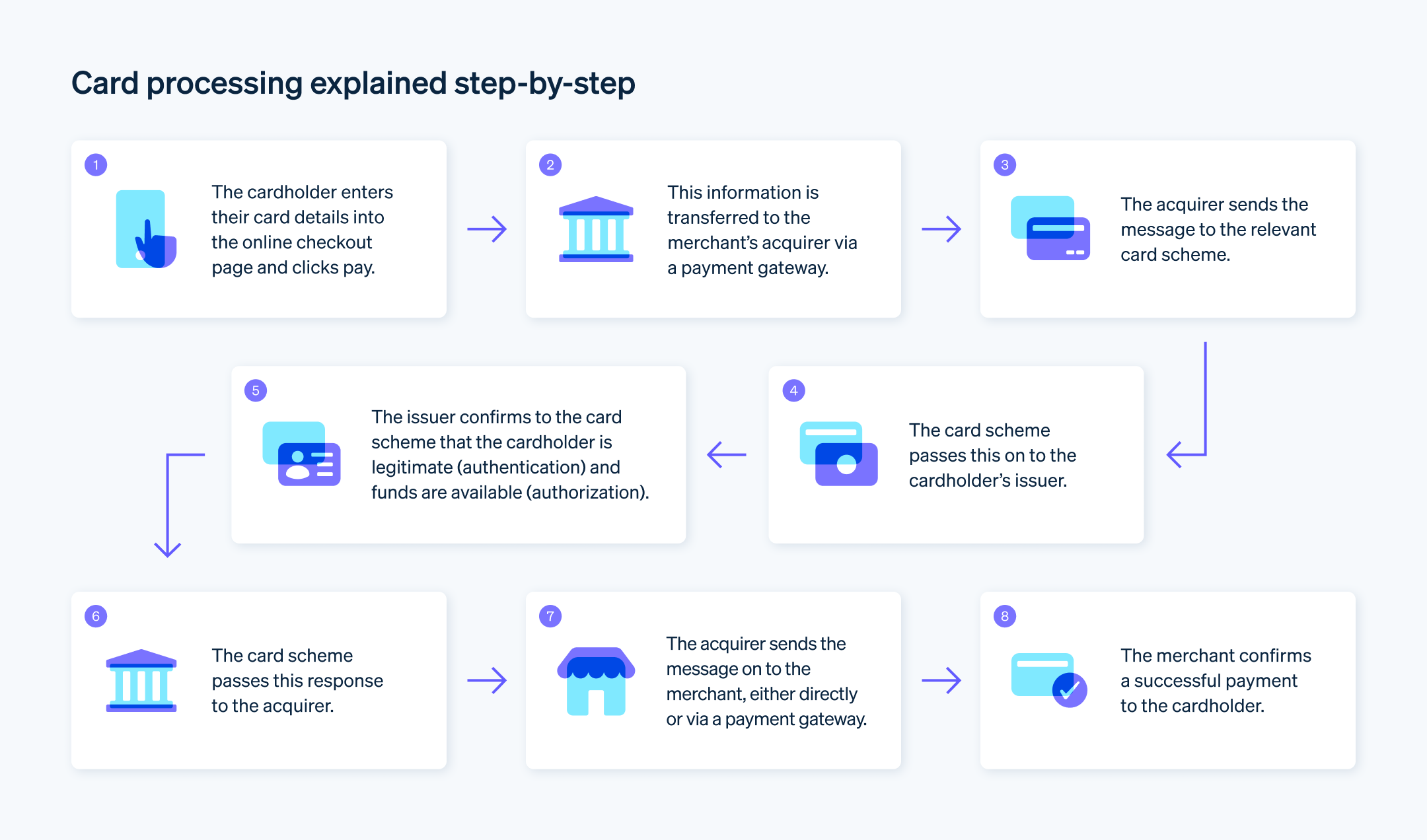支付结算是信用卡处理流程中的一个环节,指交易最终完成且资金从买家账户转入卖家账户的过程。对企业而言,此时销售或服务所得款项将存入其银行账户并可动用。支付结算是全球数字支付的重要组成部分,预计 2025 年全球数字支付规模将达到 24.07 万亿美元。
当客户进行购买时,交易会经历不同的阶段,包括授权和批处理,然后再进行结算。结算意味着金融交易的完成,使商家能够获得资金。对于信用卡支付,结算通常需要交易后一到三个营业日才能完成。此过程的速度和效率取决于交易类型,并直接影响商家的现金可用性和财务管理。
下文将探讨企业需了解的支付结算相关知识,包括其运作机制、结算周期以及实操最佳实践。
本文内容
- 支付结算流程
- 哪些人参与了支付结算系统?
- 结算周期的时间安排与周期设定
- 结算期间的安全和欺诈预防
- 支付结算的法律及合规性考虑
- 企业支付结算最佳实践
- Stripe Payments 如何提供帮助
支付结算流程
以下是支付结算流程的分步拆解说明:
1.授权: 客户发起支付后,一个销售点 (POS) 系统向收单银行发送包含交易详细信息的授权请求。收单银行将此请求转发给银行卡协会(例如 Visa、Mastercard),后者将其路由到发卡行。
2.验证: 发卡行验证交易的有效性(检查安全信息,如卡的有效期和卡验证值);确认资金或信用额度是否充足;评估风险参数,然后批准或拒绝交易。发卡行将验证结果返回给商家。
3.批准或拒绝: 根据验证结果,发卡行批准或拒绝交易。若批准,银行会在持卡人账户中保留交易金额,减少可用余额或信用额度。该保留金额专用于即将进行的交易。若拒绝,商家会收到发卡行提供的拒绝原因。
4.捕获: 商家在授权后可能不会立即捕获交易。这在最终购买金额可能有所不同的情况下(例如,在加油站)或商品或服务在稍后交付时(例如,在在线购物中)很常见。
当商家准备好完成交易金额时,它会启动捕获过程。这可能发生在营业日结束时或提供服务之后。捕获的付款请求被发送到支付处理商或收单银行,指示该实体以授权金额完成交易。
5.批处理: 批处理是指商家将当天的所有授权交易(作为批次组合在一起)发送到其支付处理商。这是支付结算的前置环节。
6.清算和交换: 收单银行将批量交易转发给卡组织。卡组织将这些交易路由至相应的发卡行并计算交换费(即银行之间为接受基于银行卡的交易而支付的费用)。
7.结算: 发卡行将适当的资金转入卡组织。卡组织通常在一到三个营业日内将这些资金转移到收单银行。
8.资金结算: 商家账户会收到净交易金额(总交易金额扣除交换费、收单行费用及其他适用费用后的余额)。结算标志着银行之间资金转移的完成,而资金结算则是资金实际进入商家账户时。
9.对账: 企业通过核对自身记录的交易金额与已结算到账的资金金额,完成账户对账工作。这一操作能发现各类金额差异,助力解决交易处理相关的问题。

哪些人参与了支付结算系统?
支付结算涉及多个具有特定职责和职能的不同实体。这些实体合作创建安全、可靠的支付系统,以处理每小时数百万笔信用卡交易。
企业: 这是销售商品或服务的实体。它接受使用商家账户的客户付款,商家账户是一种允许企业接受借记卡和信用卡支付的银行账户。商家账户在资金转入企业主经营银行账户前存放资金。
客户(持卡人): 客户是使用信用卡、借记卡等支付方式购买商品或服务的个人或实体。
收单行(企业的银行): 收单行是协助企业处理信用卡和借记卡交易的合作伙伴。它为企业提供接受卡支付所需的工具和银行账户,并将企业的交易传递给相应的发卡行以接收付款。
发卡行(客户的银行): 这是为客户发放信用或借记卡的银行。发卡行负责代表客户向收单行付款,然后向客户收取付款。
支付处理商: 通常是第三方公司。支付处理商是管理企业、收单行和卡组织之间交易流的实体。它提供处理交易所需的技术和服务,包括授权、批处理和结算功能。
卡组织(支付网络): 这些卡组织促进了各方之间财务信息和资金的电子转移。包括 Visa、Mastercard、American Express 和 Discover。卡组织制定卡交易的规则和标准,并提供处理交易的基础设施。
支付网关: 支付网关为企业处理信用卡支付。它们促进了支付门户(例如网站或手机)与支付处理商或收单行之间的信息传输。
结算周期的时间安排与周期设定
支付结算系统按照不同的时间表运行。在信用卡的典型时间线中,交易会立即获得授权,然后在每个营业日结束时进行批量处理和发送。隔夜完成清算,交易后一至三个营业日内完成结算。交易完成后需要两到三个营业日才能完成资金到账。
信用卡支付的结算时间范围可能会有所不同,具体取决于相关方和所使用的具体处理系统。当日结算,资金会在同一营业日内转入商家账户。次日或一日结算通常在隔夜处理交易,资金在下一个营业日到账。采用业内常见的两天或标准结算,公司在交易后两个营业日收到资金。较长的结算周期可能适用于高风险企业或国际交易。
以下是其他交易类型的流程和时间表。
自动清算所 (ACH) 交易
发起: 发起人向其银行发送支付指令,该操作可在任意时间进行。
批处理: 银行在预定时间(每四到六个小时左右一次)对 ACH 支付进行批处理,而不是像银行卡交易那样每天一次。
清算: 批量交易发送至中央 ACH 操作员,该操作员对其分类,并向收款人的银行发送指令。
结算: ACH 交易通常在批次发送后的下一个营业日进行结算。
资金到账: 收款人的银行会在结算的当天将资金存入账户。
电汇
发起: 发送方在其银行启动电汇。
传输: 发送方的银行通过网络传输交易详细信息,例如全球银行间金融电信协会 (SWIFT)。
结算: 电汇通常在几小时内完成结算,是国际资金转账最快的方式之一。
资金到账: 收款人的账户在同一天或 24 小时内到账,具体取决于银行的截止时间和时区。
数字钱包
交易: 数字钱包(例如,Apple Pay)提供商在付款后立即启动转账流程。
处理: 钱包提供商可能会短暂持有资金,以执行安全检查和欺诈分析。
结算: 数字钱包支付的结算通常在一到三个营业日内完成。
资金到账: 商家可在初始交易后的 2 至 3 个工作日内获取资金。
全球支付网络
发起: 对于国际银行转账,银行通过 SWIFT 网络发送支付订单。
处理: SWIFT 将消息转发给收款人的银行。银行可能会使用中介银行来促进转账。
结算: 结算时间可能从一到四个营业日不等,具体取决于全球支付网络和所涉及的银行。
资金到账: 收款银行处理付款后,收款人即可获得资金。
结算期间的安全和欺诈预防
支付结算中的安全和欺诈预防是一项协作工作。Visa 和 Mastercard 等支付网络拥有强大的欺诈检测系统,它们与发卡行和收单银行共享有关可疑活动的信息。
发卡行监控交易是否存在欺诈行为,如果发现可疑活动,可能会联系持卡人进行验证。收单行还与支付网络和发卡行合作,以防止欺诈交易。
以下是一些常用的安全措施和欺诈预防工具,可以保护支付过程。
安全措施
加密: 敏感数据(例如信用卡号码)在传输过程中加密,使其无法被未经授权的各方读取。
授权: 身份验证核验付款人和收款人的身份。这可能涉及多因素身份验证或在线交易的密码验证。
令牌化: 令牌化在交易过程中用唯一令牌替代银行卡信息,即便发生数据泄露,也能降低账户信息被盗用的风险。
访问控制: 对敏感金融数据的访问仅限于授权人员和系统。
防火墙和入侵检测: 这些系统可防止未经授权访问金融系统。
欺诈预防措施
交易监控: 分析交易模式,寻找可疑活动,例如来自异常地点的大额采购。
速率检查: 监控交易的频率和数量,以识别可能利用被盗凭证的尝试。
地址验证服务 (AVS): 将付款人提供的账单地址与其银行存档的信息进行比较。
银行卡验证值 (CVV): 付款人必须验证唯一的 CVV 代码,以确认他们在线上交易期间拥有实物银行卡。
风险评分: 根据购买历史、地点等因素为每笔交易分配风险评分,高风险评分交易可能会被标记以供进一步审查。
支付结算的法律及合规性考虑
支付结算流程受一系列法律法规的约束,这些法律和法规管理其安全性以及与国家和全球标准的符合性。企业必须遵守其经营所在管辖区的这些法律法规。
对于国际结算,企业必须考虑所有相关司法管辖区的法律要求,包括货币管制、报告要求和跨境交易法规。所有企业都必须保持准确的交易记录,并准备好在必要时向监管机构报告。
支付结算相关合规要求包括金融监管机构制定的标准,例如美国的金融犯罪执法网络 (FinCEN)和英国的金融行为监管局 (FCA)。以下是与支付结算相关的受监管领域:
反洗钱 (AML): AML 法规旨在防止与非法活动相关的资金流动。企业必须实施有效的 AML 计划,包括客户身份验证 (KYC) 流程,以验证客户身份并监控可疑活动。
打击资助恐怖主义 (CFT): CFT 法规防止利用金融系统为恐怖活动提供资金。公司必须遵守 CFT 措施,以防止滥用支付系统。
数据保护和隐私: 数据保护法规保护客户信息的隐私和完整性。公司必须遵守欧盟数据保护法规,例如《通用数据保护条例》(GDPR)。
消费者保护法: 消费者保护法保护客户在金融交易中的权利。它们授权透明地披露费用、对交易提出异议的权利以及防止未经授权的支付。
支付卡行业数据安全标准 (PCI DSS): PCI DSS 确保银行卡交易的安全并防止数据泄露。所有处理银行卡支付的企业都必须遵守该规定。
合同义务: 与支付处理商、银行和其他金融合作伙伴的协议通常包含法律和合规义务。这些合同必须与更广泛的监管要求保持一致。
企业支付结算最佳实践
您可以采取以下一些措施来促进支付结算:
支付控制: 建立完善的支付监管框架,合理划分职责以确保无人拥有过度控制权,且从交易发起至对账的每个环节都经过双重核验。
安全措施: 使用超过行业基准的支付平台,例如 PCI DSS。让您的系统保持最新并采取强大的加密措施来保护每笔交易。
对账: 养成习惯,用银行对账单和财务记录来核对您的支付活动。快速对账可帮助您及早发现任何不匹配、打击欺诈并保持财务数据准确。
合规: 不断审查影响您的支付活动的任何本地和全球规则。从反洗钱到数据保护,请确保您了解并完全遵守这些法规。
客户身份验证 (KYC): 使用客户身份验证 (KYC) 实践来确认客户的身份并降低欺诈风险。
支付条款: 在每份合同中明确您的支付条件,包括支付时间表和错过截止日期时的罚款。
争议: 制定处理撤单或争议的流程,确保能够迅速响应,并详细记录发生的情况及解决方式。
员工培训: 定期对您的团队进行培训和更新,了解最新的支付安全和合规性,以应对新的威胁和监管变化。
数据保护: 遵守所有适用的数据保护法,并通过严格的访问协议保护客户的数据。
交易监控: 监控支付交易是否有任何异常情况。定期审核可帮助您发现并解决支付流程中的任何问题。
供应商评估: 如果您与第三方支付处理商合作,请确保他们符合行业标准和法规。
备份计划: 制定备份计划,以确保即使面对技术故障、人工错误或自然灾害等中断,支付流程仍能继续运作。
Stripe Payments 如何提供帮助
Stripe Payments 提供一体化的全球支付解决方案,帮助任何企业——从成长型初创公司到全球性企业——在全球范围内接受线上和线下付款。
Stripe Payments 可帮您:
- 优化结账体验:通过预构建的支付用户界面、超过 100 种支付方式以及 Stripe 的数字钱包 Link,营造顺畅的客户体验,并节省数千个工程小时。
- 更快地拓展新市场: 覆盖全球客户,并通过跨境支付选项降低多币种管理的复杂性和成本,服务覆盖 195 个国家、支持 135 种以上货币。
- 整合线下与线上付款: 整合线上与线下渠道,打造统一的商务体验,实现个性化互动、回馈忠实客户并增加收入。
- 优化支付性能: 通过一系列可定制、易于配置的支付工具提升收入,包括无代码的欺诈保护功能与提高授权率的高级功能。
- 依托灵活可靠的平台加速业务增长: 采用专为弹性扩展设计的平台架构,提供 99.999% 正常运行时间与业界领先的可靠性保障。
了解关于 Stripe Payments 如何助力线上与实体支付业务的更多信息,或立即开始使用。
本文中的内容仅供一般信息和教育目的,不应被解释为法律或税务建议。Stripe 不保证或担保文章中信息的准确性、完整性、充分性或时效性。您应该寻求在您的司法管辖区获得执业许可的合格律师或会计师的建议,以就您的特定情况提供建议。